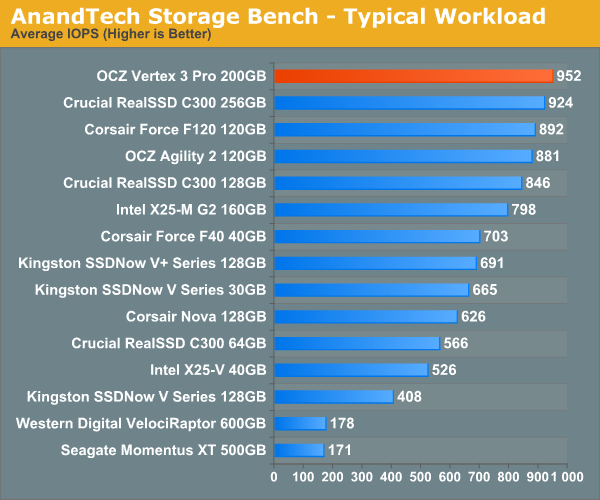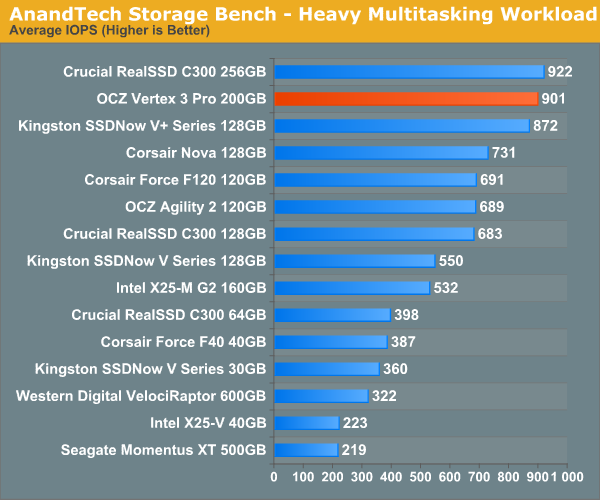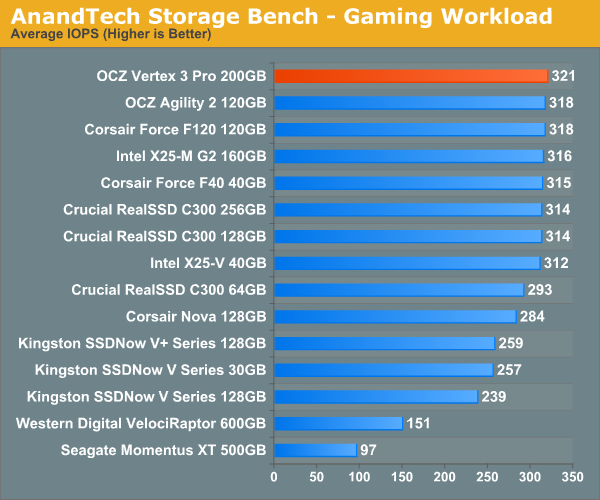OCZ Vertex 3 Pro Preview: The First SF-2500 SSD
by Anand Lal Shimpi on February 17, 2011 3:01 AM ESTAnandTech Storage Bench 2010
To keep things consistent we've also included our older Storage Bench. Note that the old storage test system doesn't have a SATA 6Gbps controller, so we only have one result for the Vertex 3 Pro (and the C300). The SF-2500 controller does respectably here, but with a 3Gbps controller we're only marginally faster than other SSDs (which is why we've moved to a new storage platform for 2011).
The first in our benchmark suite is a light/typical usage case. The Windows 7 system is loaded with Firefox, Office 2007 and Adobe Reader among other applications. With Firefox we browse web pages like Facebook, AnandTech, Digg and other sites. Outlook is also running and we use it to check emails, create and send a message with a PDF attachment. Adobe Reader is used to view some PDFs. Excel 2007 is used to create a spreadsheet, graphs and save the document. The same goes for Word 2007. We open and step through a presentation in PowerPoint 2007 received as an email attachment before saving it to the desktop. Finally we watch a bit of a Firefly episode in Windows Media Player 11.
There’s some level of multitasking going on here but it’s not unreasonable by any means. Generally the application tasks proceed linearly, with the exception of things like web browsing which may happen in between one of the other tasks.
The recording is played back on all of our drives here today. Remember that we’re isolating disk performance, all we’re doing is playing back every single disk access that happened in that ~5 minute period of usage. The light workload is composed of 37,501 reads and 20,268 writes. Over 30% of the IOs are 4KB, 11% are 16KB, 22% are 32KB and approximately 13% are 64KB in size. Less than 30% of the operations are absolutely sequential in nature. Average queue depth is 6.09 IOs.
The performance results are reported in average I/O Operations per Second (IOPS):

If there’s a light usage case there’s bound to be a heavy one. In this test we have Microsoft Security Essentials running in the background with real time virus scanning enabled. We also perform a quick scan in the middle of the test. Firefox, Outlook, Excel, Word and Powerpoint are all used the same as they were in the light test. We add Photoshop CS4 to the mix, opening a bunch of 12MP images, editing them, then saving them as highly compressed JPGs for web publishing. Windows 7’s picture viewer is used to view a bunch of pictures on the hard drive. We use 7-zip to create and extract .7z archives. Downloading is also prominently featured in our heavy test; we download large files from the Internet during portions of the benchmark, as well as use uTorrent to grab a couple of torrents. Some of the applications in use are installed during the benchmark, Windows updates are also installed. Towards the end of the test we launch World of Warcraft, play for a few minutes, then delete the folder. This test also takes into account all of the disk accesses that happen while the OS is booting.
The benchmark is 22 minutes long and it consists of 128,895 read operations and 72,411 write operations. Roughly 44% of all IOs were sequential. Approximately 30% of all accesses were 4KB in size, 12% were 16KB in size, 14% were 32KB and 20% were 64KB. Average queue depth was 3.59.

The gaming workload is made up of 75,206 read operations and only 4,592 write operations. Only 20% of the accesses are 4KB in size, nearly 40% are 64KB and 20% are 32KB. A whopping 69% of the IOs are sequential, meaning this is predominantly a sequential read benchmark. The average queue depth is 7.76 IOs.











144 Comments
View All Comments
Slimline - Thursday, February 17, 2011 - link
This sounds interestingTrefugl - Thursday, February 17, 2011 - link
Indeed. I'm particularly liking the conclusion:'We're still a couple months away from knowing exactly what to buy, but if you've been putting off that move to an SSD - 2011 may be the year to finally pull the trigger"
That pretty much describes me perfectly. I do have an SSD in my work's workstation, but for home, but I've been holding out for 2011 (IMFT 25nm NAND) and I'm thinking I might not be disappointed by the wait.
Drag0nFire - Friday, February 18, 2011 - link
Indeed. I'm particularly excited to see what will happen when Intel shows up to the fight.MeanBruce - Friday, February 18, 2011 - link
Intel announced their 510 SSD G3 series today, it will come in 120Gb and 250Gb capacities, SATA3 6Gb/s, read/writes of 470Mb/s and 315Mb/s respect, and will be priced at $280 and $580! It's not using an Intel controller word is Intel doesn't have an in house controller with any real speed! SandForce is really shakin' things up! ;)MrBrownSound - Friday, February 18, 2011 - link
woah, no kidding. I'm looking forward to any reviews of it.MeanBruce - Saturday, February 19, 2011 - link
I knew when Intel pulled their G3 SSD lineup by rescheduling the release it had nothing to do with time constraints and everything to do with the numbers released shortly after by OCZ about their new SandForce controllers, 500/500 read/writes had Intel drawing up an entirely new gameplan for the new G3 lineup! But honestly I thought they would just let a little more magic out of the bag, I had no idea their bag was empty! Now I found out the new 510 series that becomes available March 1st is just going to use a Marvell controller just like the new Crucial and Corsair drives. I still love my X-25M but it's sad when a company with that many resources kicks back on their laurels. Oh well the good news is SandForce is here and with their new client Seagate we will have lots of choices and overall it's just great for the industry at large! Just sucks to watch the one time leader down so low!Out of Box Experience - Saturday, February 19, 2011 - link
Over 50% of the boxes on the Planet still run XPSo, the big question is...
Which one is XP compatible Out of the Box?
I'd love to buy a Sata 3 SSD that can saturate my XP Sata 2 ports but should we stick with Older/Slower Intel Sata 2 SSD's for compatibility??????
Any comment on this issue?
anactoraaron - Monday, February 21, 2011 - link
I know everyone has their own reason for keeping XP... but if you want to buy a $200+ SSD how can you not pony up the 100 for windows 7?Besides, 2 more years until XP is officially obsolete...
Out of Box Experience - Monday, February 21, 2011 - link
Bla bla blaHaving Windows 7 does not mean we all need to throw out our XP Licences and all our software that does not run on 7
Why can't somebody just answer my question instead of changing the subject
We get it! You love all the spyware and DRM built into Windows 7 but others don't
So lets just stick to the question I asked shall we?
Which Sata 3 SSDs will be Alignment agnostic at the very least so they can be used on ANY O.S. besides Spyware 7?
bennyg - Monday, February 21, 2011 - link
Bla bla bla spyware bla drm bla blaYou forgot to mention how locking DX10 to Vista/7 was a deliberate ploy to force gameplayers to upgrade.
And how Win7 is just Vista done right.
Far out some people hold grudges. I was ambivalent about Win7 when it was forced upon me - but for multicore + SSDs you just can't consider an old OS that wasn't designed when they were on the radar.